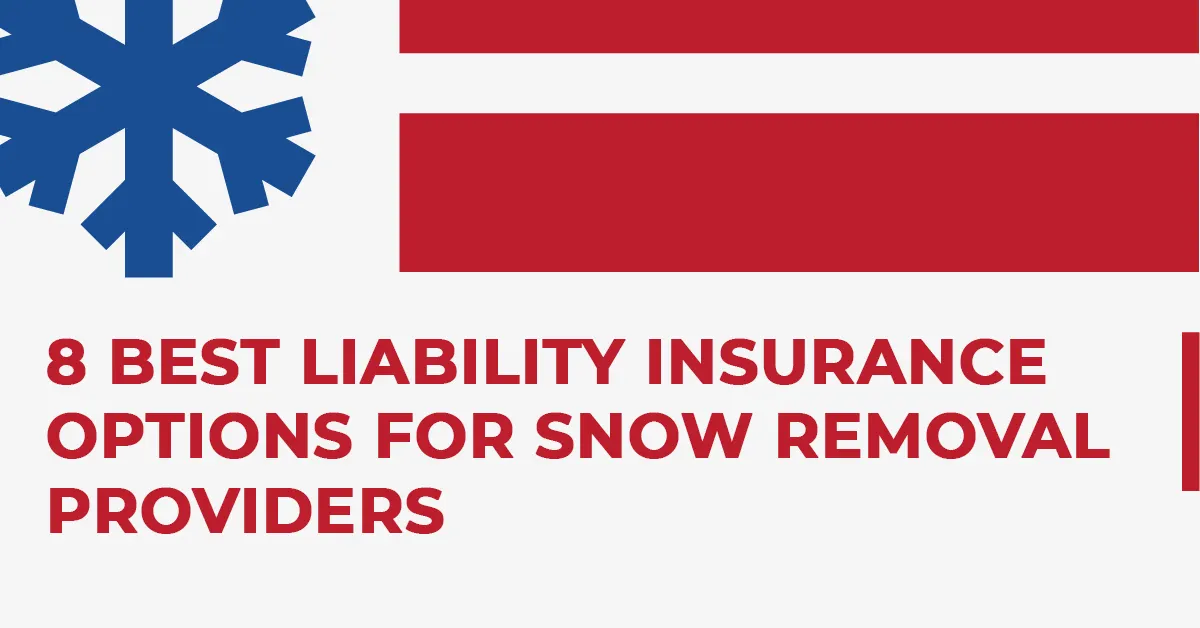
As a snow removal provider, navigating the risks of the industry goes beyond just using snow shovel or plow—it requires an educated approach to liability insurance to safeguard your financial stability. While general liability insurance forms the foundation, it’s the additional layers of specific policies that truly bolster your defenses against the risks of the snow removal industry.
Choosing the right insurance plan is not just a business decision but a strategic move to fortify your enterprise. In this article, we will explore a range of liability insurance options designed specifically for snow removal contractors. Let these insights serve as your roadmap, ensuring that when winter strikes, your business remains resilient and prepared to clear the path ahead with confidence.
Key Takeaways
- General liability coverage is essential for snow removal providers as it protects against claims of bodily injury and property damage, including premises liability, operations liability, and products liability.
- Commercial auto insurance is necessary to cover vehicle damage and injury protection, including collision coverage and comprehensive coverage. Policy limits should reflect the value of vehicles and equipment.
- Workers’ compensation insurance is crucial to protect employees from job-related injuries, particularly in the snow removal industry. It is a legal requirement in most states and demonstrates investment in the team’s safety and the business’s longevity.
- Umbrella policies and other specialty coverage provide additional protection beyond primary insurance, offering higher coverage caps and broadened coverage scope. Umbrella insurance kicks in when primary coverage limits are reached and can include specialty coverage for unique risks such as pollution liability, inland marine insurance, and business interruption insurance.
Understanding General Liability Insurance Coverage
General liability insurance is a fundamental necessity for snow removal providers, as it protects your business against claims of bodily injury and property damage resulting from your services. This insurance is the bedrock of risk management, shielding you from the financial fallout of accidents that can occur during the course of your work—such as slip-and-fall incidents on freshly cleared surfaces or inadvertent damage to a client’s property.
When you delve into the specifics of general liability coverage, you’ll find that it typically encompasses several key components. Firstly, it includes premises liability which covers accidents occurring on your business property. Secondly, operations liability applies to injuries or damages that happen during the actual snow removal process. Additionally, products liability is relevant if you sell any goods, such as ice-melting chemicals, that could potentially cause harm.

Another crucial feature is completed operations coverage. This protects you after a job is done, should an incident arise from the work you performed. For instance, if ice refreezes after clearing and causes an accident, this coverage may safeguard you against resulting claims.
It’s essential to understand that general liability insurance doesn’t cover everything. Worker’s compensation, automobile accidents, and professional liability are typically excluded and require separate policies. Furthermore, policy limits and deductibles will play a significant role in determining your out-of-pocket costs in the event of a claim.
As you evaluate insurance options, make sure you’re clear on the scope of coverage provided. A policy that seems cheaper upfront may not offer the comprehensive protection you need, leaving you exposed to potential risks. Your goal should be to balance affordability with the breadth and depth of coverage, ensuring your snow removal business is well-protected against the perils of winter work.
Commercial Auto Insurance Essentials
As a snow removal provider, you’re well aware of the hazards your vehicles face during operations. Commercial auto insurance is critical, as it covers vehicle damage and ensures that you’re protected in case of injury. It’s an indispensable component of your risk management strategy, safeguarding your business against potential financial setbacks.
Coverage for Vehicle Damage
Understanding the essentials of commercial auto insurance is crucial for snow removal providers to ensure their vehicles are protected against potential damages. As you navigate icy roads and harsh conditions, your equipment is at risk. Commercial auto insurance offers coverage for vehicle damage that can occur during snow removal operations. This includes collision coverage for accidents involving other vehicles or objects, and comprehensive coverage for non-collision incidents such as vandalism, theft, or environmental damage.
It’s imperative that your policy limits reflect the value of your vehicles and equipment. Analyze the terms carefully; some policies may exclude certain types of damage or require additional riders. Ensure you’re not underinsured—vehicle repairs or replacements without adequate coverage can significantly impact your business financially. Prioritize a tailored insurance solution that addresses the unique risks faced by your snow removal fleet.
Policyholder Injury Protection
Beyond the safeguarding of vehicles, commercial auto insurance is essential for protecting snow removal operators from injuries sustained while on the job. This protection is a linchpin for mitigating financial risks associated with accidents. When you’re behind the wheel, or even exiting the vehicle on icy terrain, the risk of injury looms. If an accident occurs and you’re injured, your policy’s medical coverage can help cover the costs of medical care and rehabilitation. It’s imperative to analyze the policy details — ensuring the limits are sufficient and the coverage is comprehensive. This not only cushions against unforeseen medical expenses but also safeguards your livelihood. Remember, an injury can sideline you, impacting your ability to earn. Thus, robust coverage is not just beneficial; it’s critical for your financial resilience.
Workers’ Compensation for Snow Crews
Securing workers’ compensation insurance is a crucial step for snow removal businesses to protect their crews from job-related injuries and financial loss. As a provider of snow removal services, you’re well aware of the risks your employees face each winter. Slips, falls, and exposure to cold temperatures can lead to injuries that not only affect their well-being but also your business’s financial stability.
Workers’ compensation insurance serves as a safeguard, ensuring that if your employees are injured while clearing snow, they receive the medical attention and financial support necessary to recover and return to work. This coverage is not just a safety net for your staff; it’s a legal requirement in most states.
When considering workers’ compensation for your snow crews, focus on these key elements:
- Coverage Scope: Ensure the policy covers the types of injuries common in snow removal, such as musculoskeletal injuries from shoveling or slips on ice.
- Cost Management: Look for policies that offer competitive premiums without compromising on the level of coverage. Remember, lower premiums could mean higher out-of-pocket expenses later.
- Claims Support: Choose an insurer known for efficient claims processing. Quick and supportive claims handling can minimize downtime and maintain morale among your crew.
Your analysis of workers’ compensation options should be as meticulous as the planning of your snow removal routes. You’re not just buying a policy; you’re investing in your team’s safety and your business’s longevity. By choosing the right workers’ compensation insurance, you’re taking a proactive stance towards risk management, which can lead to reduced injuries and lower insurance costs in the long run. Remember, a protected crew is a productive crew.
Umbrella Policies for Additional Protection
As a snow removal provider, you’re aware that your basic liability insurance has limits that may not cover all potential claims. An umbrella policy offers you an additional layer of protection, extending coverage limits beyond your primary insurance policies. It’s crucial to understand the differences between umbrella and excess liability insurance, as well as how the costs of these policies impact your business’s financial security.

Extending Coverage Limits
To enhance your protection beyond standard liability limits, consider investing in an umbrella insurance policy that offers additional coverage layers for snow removal businesses. This type of policy kicks in once the limits of your underlying policies have been reached, providing a safety net against claims that exceed those primary coverage amounts.
- Higher Coverage Caps: Umbrella insurance raises the ceiling on your liability protection, shielding you from potentially ruinous legal judgments or settlements.
- Broadened Coverage Scope: It may cover certain liabilities not included in standard policies, filling gaps in your risk management strategy.
- Cost-Effective Peace of Mind: Adding substantial coverage with an umbrella policy is often more affordable than increasing the limits of existing policies.
Umbrella Vs. Excess Liability
Understanding the differences between umbrella and excess liability insurance policies is crucial for snow removal providers seeking comprehensive coverage. Umbrella insurance not only extends your existing liability limits but also broadens coverage for claims that may not be included in your underlying policies, such as certain legal fees or slander. In contrast, excess liability serves as an extension of your current limits on an existing policy without altering the scope of coverage.
You’ll find umbrella insurance indispensable when a claim exceeds your base policy’s limits and falls outside standard coverage areas. Excess liability is more straightforward, simply providing additional monetary cushioning. Carefully assess your business risks to determine which option best fortifies your financial defenses against potential claims.
Policy Cost Considerations
When considering umbrella policies for additional protection, you must weigh the costs against the potential financial risks of operating without such coverage. Umbrella policies provide a safety net beyond your standard liability limits, but it’s crucial to analyze the expense in relation to your business’s exposure to liability claims.
- Premium Factors: The cost of an umbrella policy is influenced by your business’s size, location, and claims history.
- Coverage Limits: Higher limits equate to higher premiums, but also offer greater peace of mind.
- Risk Assessment: Consider the frequency and severity of potential claims in the snow removal industry.
Inland Marine Insurance Explained
Inland Marine Insurance provides essential coverage for equipment and property in transit, safeguarding your assets beyond the confines of your primary business location. As a snow removal provider, you’re constantly on the move, transporting snowplows, blowers, and other specialized gear from site to site. This type of insurance is designed to protect your movable property against the risks of theft, loss, or damage that can occur while it’s on the road or stationed at a job site—risks not typically covered by standard commercial property insurance.
What sets Inland Marine Insurance apart is its ability to adapt to the specific needs of your operation. You’ll find that policies can be tailored to cover a variety of equipment types and transportation scenarios. For example, if you’re hauling a commercial-grade snow blower to a client’s property and it’s damaged in a collision, this insurance can help cover repair or replacement costs, ensuring you don’t bear the financial burden alone.
Furthermore, consider the contractual requirements you may encounter. Clients often demand proof of comprehensive insurance coverage before allowing you to commence work. Demonstrating that you have Inland Marine Insurance can satisfy these requirements and position you as a reliable and professional service provider.
It’s critical to review the policy details with your insurer. Pay attention to the limits, deductibles, and exclusions to ensure they align with your risk profile. By doing so, you ensure that your investment in equipment is protected as it generates revenue for your business. Remember, a proactive approach to insurance isn’t just about compliance; it’s about safeguarding the continuity of your operations.
Professional Liability for Snow Services
While safeguarding your equipment with Inland Marine Insurance is crucial, it’s equally important to consider the financial risks associated with the professional services you provide, making Professional Liability coverage an indispensable asset for your snow removal business. This type of insurance, often referred to as Errors and Omissions (E&O) insurance, protects your enterprise against claims of negligence or harm due to professional advice or services rendered.
Professional Liability insurance is designed to shield your business from potentially crippling financial judgments. Here’s what this coverage typically includes:
- Defense Costs: Legal fees can quickly accumulate, even when claims are groundless. Professional Liability covers these costs so you’re not out-of-pocket.
- Judgments or Settlements: If a claim against your snow removal service results in a judgment or settlement, this insurance can help cover the awarded amounts.
- Claims and Damages: Coverage extends to claims of professional negligence, such as advice that leads to client losses, or damages due to mistakes in provided services.
As you analyze your insurance needs, understand that general liability insurance doesn’t encompass the unique professional risks you face in snow services. A slip-and-fall claim resulting from alleged inadequate snow removal, for instance, could be a matter for General Liability, but if the allegation involves a failure in your professional judgment, it’s Professional Liability that you’ll rely on.
Tailoring a Professional Liability policy to the distinct challenges of snow removal services ensures that you’re not only meeting contractual requirements but also proactively managing risk. Consult with an insurance specialist to determine the appropriate coverage limits based on your business size, the scope of services, and the potential exposures you face. Remember, it’s not just about having insurance; it’s about having the right insurance.
Property Insurance for Snow Equipment
Your snow removal business relies heavily on specialized equipment, making Property Insurance a crucial safeguard against potential damages or loss. This type of insurance is designed to cover the tools and machinery that are essential to your operations, such as snowplows, salt spreaders, and blowers. In the event of theft, vandalism, or natural disasters, property insurance steps in to provide financial protection, ensuring that your ability to operate isn’t crippled by the unexpected costs of replacing or repairing vital equipment.
When evaluating Property Insurance policies, you need to consider the full replacement value of your equipment. It’s not enough to insure for what you paid years ago; you must account for current market prices to avoid being underinsured. Additionally, assess the specific risks associated with your geographical location and services. Areas prone to severe winter storms or erratic weather patterns may necessitate more comprehensive coverage.
Furthermore, look into whether your policy includes coverage for business interruption. This can compensate for income lost during periods when equipment damage prevents you from operating. This aspect of your policy can be the difference between staying afloat or facing financial hardship during downtime.
Keep in mind that standard Property Insurance may not cover all risks. It’s important to read the fine print and understand any exclusions. You might need to purchase additional riders or specialized policies for complete coverage, such as an inland marine policy for equipment that’s frequently in transit.
In short, don’t skimp on insuring your equipment. Effective Property Insurance coverage is not just about meeting basic requirements; it’s about ensuring the longevity and resilience of your snow removal business. Analyze your needs carefully and choose a policy that provides robust protection tailored to the unique risks you face.
Specialty Coverage for Unique Risks
Snow removal businesses must also consider Specialty Coverage to address risks that standard policies typically exclude. While general liability insurance forms the backbone of your risk management strategy, it does not cover all eventualities. As a snow removal service provider, you’re exposed to unique perils that demand specialized attention. Analyzing potential gaps in your coverage is crucial to ensure that you’re fully protected against the unpredictable nature of your work.
Specialty Coverage can fortify your business against incidents that are not just rare but can also be financially catastrophic. This type of insurance is tailor-made to safeguard against the specific risks associated with snow removal operations. Consider the following types of Specialty Coverages:
- Pollution Liability: This covers claims related to accidental environmental contamination resulting from your snow removal activities, such as salt or chemical runoff.
- Inland Marine Insurance: It provides protection for equipment that is frequently in transit or stored at various locations, ensuring that your mobile assets are covered.
- Business Interruption Insurance: This compensates for lost income if your operations are halted due to a covered event, such as a major equipment breakdown.
To navigate the complexities of Specialty Coverage, it’s advisable to work with an insurance provider experienced in the snow removal industry. They can help you assess your exposure to unique risks and recommend the appropriate coverages. Remember, the cost of such policies is negligible compared to the financial impact of an uncovered claim. Your goal should be to create a comprehensive insurance portfolio that minimizes vulnerabilities and ensures the continuity of your business operations, regardless of what winter throws your way.